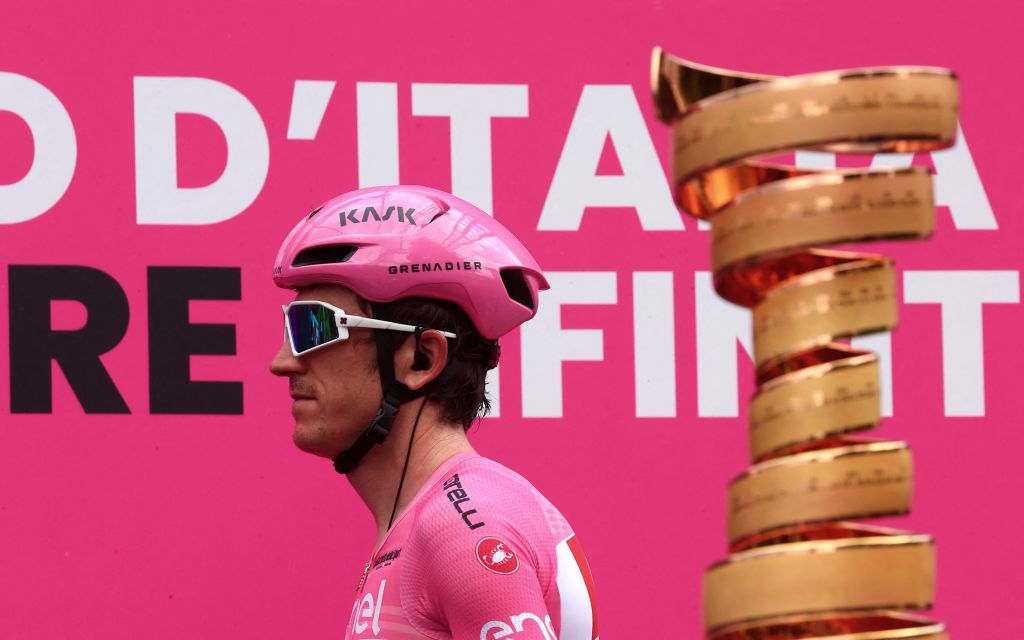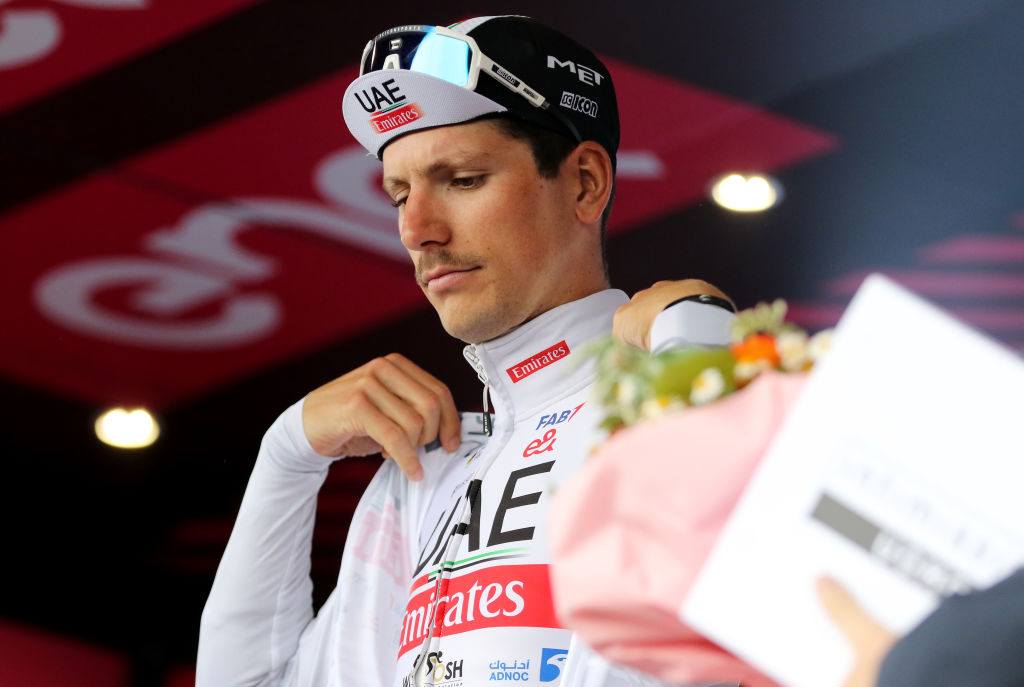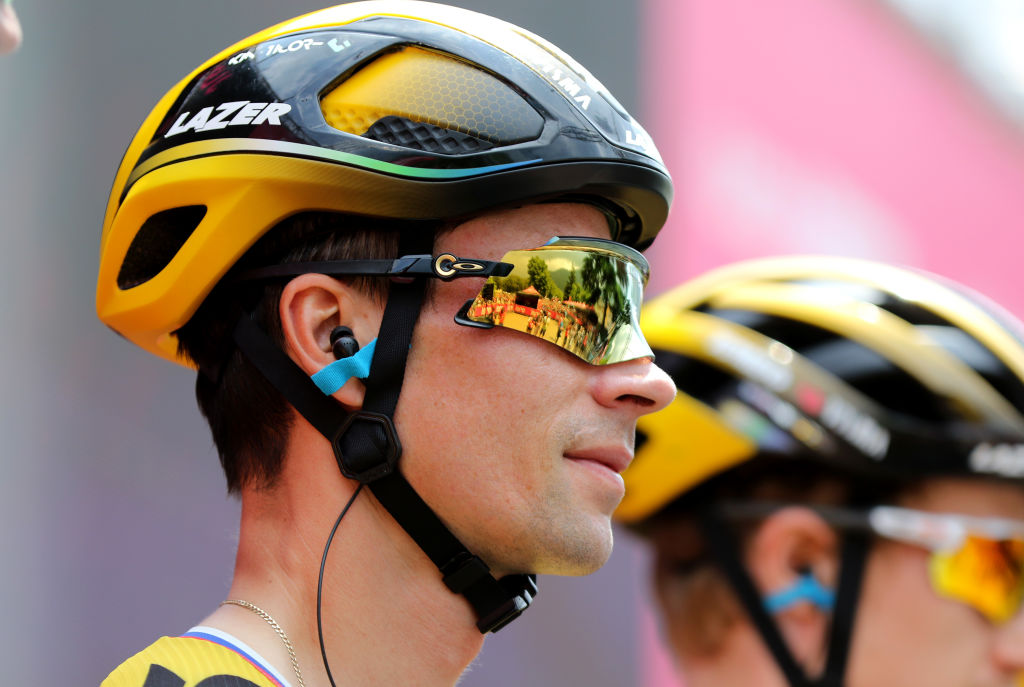
Three riders, three days, 29 seconds. After two and a half weeks that saw altogether more attrition than action, the Giro d’Italia is down to the last men standing. The race may have been low on excitement before Monte Bondone, but there is no shortage of suspense as it enters its final phase with Geraint Thomas (Ineos Grenadiers), João Almeida (UAE Team Emirates) and Primož Roglič (Jumbo-Visma) all firmly in the hunt for overall victory.
There are compelling arguments why each man might lift the Trofeo Senza Fine on Sunday evening as the sun sets behind the Capitoline Hill in Rome, and each rider has reason to believe the road ahead suits him every bit as well as his rivals.
First up is the 161km run to the two-part climb to Val di Zoldo on stage 18, where the penultimate ascent of Coi, with its 19% slopes, might force some separation among the top three. On Friday, the Giro takes on the Dolomite tappone to Tre Cime di Lavaredo, a second successive day with more than 5,000m of climbing. And on Saturday, of course, there is the daunting Monte Lussari time trial, subject to so much discussion even before this Giro began.
There has been little to separate Thomas, Almeida and Roglič to this point on the road, and even less to separate them on paper in the days to come. All three are robust climbers and time triallists, and they are backed by the three strongest teams in the race. Ultimately, the decisive factor will likely prove to be endurance. The rider who outlasts his rivals in this final slog will carry pink to Rome. It’s as simple and brutally complicated as that.
“Ultimately, you’re all getting more and more tired at the end of a race like this,” Jumbo-Visma directeur sportif Marc Reef told Cyclingnews. “So if you are less tired relative to the others, then you have a good chance."
Geraint Thomas

Thomas carries the maglia rosa into this troika of stages with a lead of 18 seconds over Almeida and 29 seconds over Roglic. The Welshman has scarcely put a pedal stroke askew thus far, with his only off-key showing coming in the opening time trial to Ortona. Since then, he has been present and correct at every critical juncture, tracking Roglič's attack on I Cappuccini on stage 8 and bridging up to Almeida on Monte Bondone on stage 16.
Before this Giro, much was made of Thomas’ unfortunate record at this race, the crashes that forced him out of the reckoning in 2017 and 2020. At this juncture, his track record in the Grand Tours where he has managed to stay upright was of altogether greater relevance. His 2018 Tour de France victory will remain forever the emotional high point of his career, but his subsequent podium places in 2019 and 2022 are testament to his ability to withstand the rigours of a Grand Tour’s dying days.
Thomas’ third-place finish at last year’s high-octane Tour, in particular, had caught the eye of Jay Vine ahead of the race, who even reckoned that it made him at least as much of a favourite for the Giro as Roglič and the since-departed Remco Evenepoel.
The past two weeks or so have borne out that prognosis, but there are still points of concern for Thomas and Ineos Grenadiers. The first is obvious – his Ineos team has lost Tao Geoghegan Hart, Pavel Sivakov and Filippo Ganna, and it will not be straightforward to defend pink with just four riders to help. It also means they might not be able to make much tactical use of the high placings of Thymen Arensman (9th at 4:09) and Laurens De Plus (10th at 4:32).
“If they put one of them in the break, that’s a way to put pressure on the others. But the downside is that they would then have a guy less in the bunch to control things for Thomas,” Jumbo-Visma's Reef said. “That’s the situation they are in, it’s difficult for them to manage that. They are down to five now, with three guys less to control the race, and that can bring opportunities for UAE and also for us.”
The other question, of course, is whether Thomas’ current buffer will suffice to fend off Almeida and Roglič in that Monte Lussari, a hybrid stage that seems to defy all predictions. Ineos directeur sportif Matteo Tosatto confessed as much to Cyclingnews on Wednesday.
“I’m happy with the GC at the moment, but I’d prefer to take time. If Geraint has an opportunity, it’s important to take time,” he said. “Saturday’s time trial is a good stage for Geraint, but I think Thursday and Friday’s mountain stages are more important for him.”
Almeida

Over at the UAE Team Emirates bus, directeur sportif Fabio Baldato evinced a little more confidence about that Monte Lussari time trial, even if he, too, acknowledged that it was ultimately a stage that could favour any one of the three contenders.
“I wouldn’t be sorry to go to the time trial in this situation,” Baldato told Cyclingnews. “But if a chance arises, you can’t wait for tomorrow, you have to try. All three of them know that. Ineos know it, Jumbo know it and so do we. It’s not a secret.”
Baldato noted, however, that Almeida had been the strongest of the three contenders on the steepest portion of Monte Bondone on stage 16, jumping clear with a shade under 6km to go, before Thomas bridged across once the gradient had begun to ease slightly.
“João made the difference where it was steeper. With his lighter weight, he was able to do it,” Baldato said. “But the Thomas we saw on Monte Bondone was at his best level, and he’s a rider who’s won the Tour de France, so we have a lot of respect for him.”
It was certainly another masterclass in pacing a climb from Thomas, though the terrain in the days ahead might not be as amenable to that strategy, most notably those evocative but vicious final ramps at Tre Cime di Lavaredo. In his press conference in Caorle on Wednesday evening, mind, Thomas confessed to ignorance of the ascent and its place in Giro lore. The mountain was conquered by Eddy Merckx in 1968, but it almost toppled him six years later.
“I don’t know much about it at all,” Thomas said by way of apology. “I’ll go on YouTube tonight."
Roglic

Although Thomas and Almeida managed to distance Roglič at Monte Bondone, both men insisted that the Giro remained resolutely a three-man race. “For me, Roglič is as dangerous now as he was on Tuesday morning before the stage. He only lost 25 seconds on the stage,” Tosatto said.
Above all, Roglič ensured he didn’t lose the Giro at Monte Bondone, thanks in no small part to a lifeline from Sepp Kuss, who steadied some turbulent waters just when his leader looked to be floundering on the steepest slopes. It was, Reef acknowledged, a cameo that might have saved Roglič’s Giro challenge.
“I think without Sepp, it could have been worse for sure,” Reef said. “But I think Primož is still feeling good and there are also different stages to come. Thursday has steep climbs in the finale, and Friday is a day where we ride almost always at altitude, so those are two completely different stages. Plus, we have the time trial, which normally suits him very well.”
It remains to be seen if Roglič’s setback at Monte Bondone was simply a bad day or an indication of a deeper malaise. He did, after all, fall rather more heavily than Thomas in the mass crash on stage 11 that forced the unfortunate Tao Geoghegan Hart out of the Giro. Reef, for his part, opted for a positive view.
“Each one of them will have a bad moment in the coming days and it’s just about making sure that you keep the time gap as small as possible to your competitors at that moment. And I think we managed that in a really good way at Monte Bondone,” Reef said. “We still have three days to come, and we are for sure still capable of winning this Giro.”
The road ahead
After Wednesday’s flat run to Caorle, the Giro returns to the mountains on stage 18 to Val di Zoldo, which takes in the Passo della Crosetta, Pieve d’Alpago and Forcella Cibiana ahead of the two-part climb towards the finish. The key moment might come on the upper reaches of Coi, where the gradient rears up to 19% before the summit with 5.4km to go. After a short descent, the road kicks up again for the stiff final haul to the line.
On Friday comes the most demanding stage of the entire Giro, the 183km grind through the Dolomites by way of the Passo Campolongo, Passo Valparola, Passo Giau and Passo Tre Croci ahead of the haunting final ascent to Tre Cime di Lavaredo (7.2km at 7.6%). Much like the dramatic finale on the nearby Marmolada a year ago, the dizzying final 3km – average gradient 12.7% – could tear a tight GC apart.
And yet the worst is still to come, with the 18.6km time trial from Tarvisio to Monte Lussari on stage 20. The vexed logistics of bringing the Giro up the mountain created headlines ahead of the Grande Partenza, but the 22% ramps near the summit might ultimately decide the outcome of the entire race.
This backloaded Giro route might have stifled the racing in the opening two weeks, but it still promises what it was designed to deliver – a most unpredictable finish.
“One bad moment on those three stages can cost you the whole race,” Reef said. “That’s why we believe that we are still in it, and so do Thomas and Almeida.”







